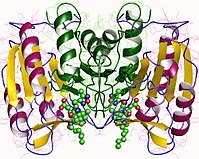
Photo from wikipedia
Caspase-3-like proteases (e.g., caspase-3 and caspase-7) constitute the core players of cell apoptosis, and their dysregulation has been linked to a number of human diseases, such as cancer and neurodegenerative… Click to show full abstract
Caspase-3-like proteases (e.g., caspase-3 and caspase-7) constitute the core players of cell apoptosis, and their dysregulation has been linked to a number of human diseases, such as cancer and neurodegenerative disorders. However, the methods for measuring caspase-3-like proteases are often complex and time-consuming. Herein, we develop a label-free method to homogeneously detect caspase-3-like proteases in vitro and in complex cell lysate. This assay uses a modular peptide that contains a dimerization domain, a caspase-3/7 cleavage sequence, and a dicysteine motif as the activity sensor to detect caspase-3-like proteases. In the absence of caspase-3-like proteases, the homodimerization of modular peptide brings the dicysteine motif into close proximity and forms a particular configuration suitable for the binding to bisarsenical dye FlAsH-EDT2. The coordination of FlAsH-EDT2 to dimeric peptide forms a highly fluorescent FlAsH-peptide complex. In contrast, the cleavage of the modular peptide by caspase-3-like proteases removes the dicysteine motif from the peptide and abrogates the bipartite tetracysteine display, leading to the disappearance of fluorescence. As a result, the caspase-3-like proteases can be quantitatively evaluated by measuring the change in fluorescence. This assay may be carried out in a "mix-and-read" manner and is, thus, quite simple and convenient. Moreover, this assay is extremely specific and can measure caspase-3 protein down to 1.28 × 10-4 μg/mL. Importantly, the assay is compatible with complex biological samples and can measure both the activation and inhibition of intracellular caspase-3, thereby providing a new approach for the screening of caspase-targeted drugs and the diagnosis of apoptosis-associated diseases.
Journal Title: Analytical chemistry
Year Published: 2017
Link to full text (if available)
Share on Social Media: Sign Up to like & get
recommendations!